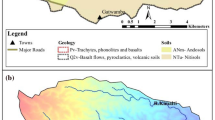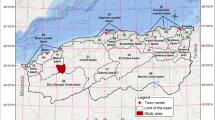Abstract
Council Regulations (EC) No 1257/1999 and the EU Soil Thematic Strategy give great importance to soil and land conservation to develop knowledge driven governance for rural development. In the hilly areas of Italy cultivated intensively, and especially in the ones devoted to viticulture, agricultural practices determine high loss of soil with consequent degradation of the soil resource. In addition to it, offsite effects of soil erosion can be unsustainable, due to sediment transfer to the channel network and infrastructures. In order to achieve a sustainable rural development there is a need for tools and instruments to allow European regional administrations, to develop, implement, manage and monitor rural development plans. To counteract the environmental threats intensified by agricultural activity, the environmental functions “soil erosion control” and “water runoff control” were investigated in the Chianti area by using GIS. To determine the EMR (Environmental Minimum Requirements) values for soil erosion the “regeneration” capability of soils was considered, and the value of estimated soil loss was compared with the value of soil reformation. A scenario analysis was also performed to evaluate the effectiveness of the agroenvironmental measure “grass cover” in reducing erosion. The concept of tolerable erosion based on soil productivity and soil reformation rate only is reductive and off-site effects of soil erosion should be also taken into account. For this reason, it was proposed to extend the concept of hydrogeological risk to soil erosion by implementing the notion of soil erosion tolerance (T) with the new concept of environmental risk of soil erosion (ERSE). The new ERSE index takes into account all the in- and off-farm externalities of soil erosion. For this reason, it can be considered an aggregated environmental indicator that enables policy makers to evaluate the impacts of soil erosion by following an holistic approach.














Similar content being viewed by others
References
Alexander EB (1988) Rates of soil formation: implications for soil-loss tolerance. Soil Sci 145:37–45
Barrow C (1994) Land degradation. Cambridge University Press, London
Bazzoffi P (2007) Erosione del suolo e sviluppo rurale—Fondamenti e manualistica per la valutazione agroambientale ed. Calderini, p 264
Bazzoffi P, Chisci G (1999) Tecniche di conservazione del suolo in vigneti e pescheti della collina cesenate. Riv Agron 3:177–184
Bazzoffi P, Chisci G, Missere D (1989) Influenza delle opere di livellamento e scasso sull’erosione del suolo nella collina cesenate. Agronomia 13(3):213–221
Borselli L (1995) Il Soil conservation service curve number method. In: Busoni E, Borselli L, Calzolai C (eds) Caratteristiche fisiche ed idrologiche del suolo: loro derivabilita’ dalla cartografia pedologica ed applicabilità in modelli distribuiti di bilancio idrologico di bacino”. Gruppo Nazionale per la difesa dalle catastrofi idrogeologiche - C.N.R. - Linea 1, pp 57–76
Buffoni L, Brunetti M, Mangianti F, Maugeri M, Monti F, Nanni T (2003) Ricostruzione Del Clima Italiano Negli Ultimi 130 Anni E Scenari Per Il Xxi Secolo. In: Atti workshop “CLIMAGRI - Cambiamenti Climatici e Agricoltura” Cagliari, 16–17 gennaio 2003, pp 7–14
De Groot RS (1992) Functions of nature. Evaluation of nature in environmental planning, management and decision making. Wolters-Noordhoff ed. ISBN 9001 355943, pp 315
Di Rosa G (2000) Rischio idrogeologico e difesa del territorio. Flaccovio, Palermo, pp 160
Doran J (1996) The international situation and criteria for indicators, chap 7. In: Cameron KC, Comforth IS, McLaren RG, Beare MH, Basher LR, Metherell AK, Kerr LE (eds) Soil quality indicators for sustainable agriculture in New Zealand: proceedings of a workshop, Lincoln Soil Quality Research Centre, Lincoln University, New Zealand
EC (European Commission) (2006) A strategy to keep Europe’s soils robust and healthy. http://ec.europa.eu/environment/soil/index.htm
EEA (1998) Europe’s environment: the second assessment. Office for official Publications of the European Communities ed., Luxembourg
Grimm M, Jones RJA, Montanarella L (2001) Soil erosion risk in Europe. European Soil Bureau, Institute for Environment & Sustainability, JRC Ispra. Office for Official Publications of the European Communities, Luxembourg ed
Heatwole CD, Shanholtz VO, Yagow ER, Collins ER (1987) Targeting animal waste pollution with Virginia GIS. Paper No. 87–4049. American Society of Agricultural Engineers, St. Joseph, MI, 15 pp
Heimsath AM, Dietrich WE, Nishiizumi K, Finkel RC (1997) The soil production function and landscape equilibrium. Nature 388:358–361
Kendall H, Pimente D (1994) Constraints on the expansion of the global food supply. Ambio 23(3):200
Moore ID, Burch GJ (1986) Sediment transport capacity of sheet and rill flow: application of unit stream power theory. Water Resour Res 22(8):1350–1360
Morando A (2001) Vigna Nuo, Materiali e tecniche per l’impianto del vigneto. Ed. Vit. En., Calosso d’Asti
OECD (2001) Environmental indicators for agriculture. Methods and results, vol 3. In: OECD (ed) Agriculture and food. ISBN 92-4-18614-X, pp 409
Owens LB, Watson JP (1979) Rates of weathering and soil formation on granite in Rhodesia. Soil Sci Soc Am J 43:160–166
Renard KG, Foster GR, Weesies GA, McCool DK, Yoder DC (1997) Predicting soil erosion by water. A guide to conservation planning with the revised universal soil loss equation RUSLE. USDA Agricultural Handbook, #703
Salviano AAC., Vieira SR., Sparovek G (1998) Erosion intensity and Crotalaria juncea yield on a Southeast Brazilian ultisol. Adv Geoecol 31:369–374
Skidmore EL (1982) Soil loss tolerance. In: Determinants of soil loss tolerance. ASA Spec. Publ. ASA, Madison, vol 45, pp 87–93
Sparovek G, De Jong VQ (1997) Definition of tolerable soil erosion values. Rev Bras Cienc Solo 21:467–471
Stallard RF (1995) Tectonic, environmental, and human aspects of weathering and erosion: a global review using a steady-state perspective. Annu Rev Earth Planet Sci 23:11–39
Stamey WL, Smith RM (1964) A conservation definition of erosion tolerance. Soil Sci 97:183–186
Varnes DJ (1984) Landslide hazard zonation: a review of principles and practise. Natural hazards, vol. 3. UNESCO, Paris, p. 63
Ven Te Chow (1964) Handbook of applied hydrology. In: Gottschalk LC (eds) Reservoir sedimentation, sect. 17. Mc. Graw-Hill, New York, pp 1–34
Ven Te Chow, Maidment DR, Mays LW (1988) Applied hydrology. McGraw-Hill Book Company, New York
Wakastsuki T, Rasyidin A (1992) Rates of weathering and soil formation. Geoderma 52:251–263
Yagow ER, Schanholtz VO, Julian BA, Flagg JM (1998) A water quality module for CAMPS. American Society of Agricultural Engineers Meeting Presentation Paper No. 88–2653
Zachar D (1982) Soil erosion. Developments in soil science, 10. Elsevier Scientific Publishing Company, Amsterdam, pp 547
Acknowledgments
Author wishes to thank Massimo Aglietti of CRA, Agricultural Research Council, Agrobiology and Pedology Research Centre, Florence, for the English revision of the text.
Author information
Authors and Affiliations
Corresponding author
Rights and permissions
About this article
Cite this article
Bazzoffi, P. Soil erosion tolerance and water runoff control: minimum environmental standards. Reg Environ Change 9, 169–179 (2009). https://doi.org/10.1007/s10113-008-0046-8
Received:
Accepted:
Published:
Issue Date:
DOI: https://doi.org/10.1007/s10113-008-0046-8




